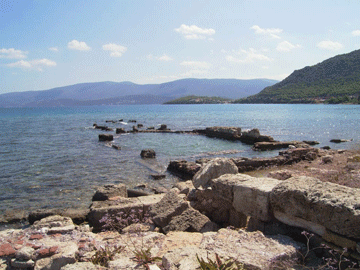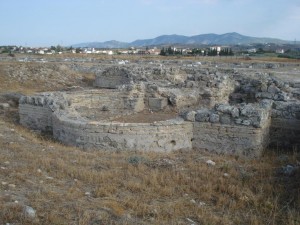Cechrea port and Saint Paul in ancient Corinth

Cechrea port Corinth
The port has been named after a small village located close to the sea inside a moorage, known as Kegrees moorage. During the years of the Roman Empire, a series of arcades had been constructed along the half-moon shaped beach, which are shown on coins of that era. Several building had been constructed on the two sea-walls which are situated on the north and the south side of the port each. The southern one was wider. The excavations brought to light foundations of several buildings in the land and the sea. Among them, there is Isis’s Temple (in the sea) and an old-Christian basilica closer to the coast. A ruined tower can be seen close to the coast, towards the edge of the north harbor breakwaters. The foundations of plinth-made buildings, dating back to the post-Roman Era, have been found on the beach. Even though Cechrea port was very important for the connection of Corinth with the ports of the East as well as with the islands, it has been mentioned much less in ancient writer’s scripts than Lechaio port which was also used as a naval dockyard. The major advantage of Lechaio was the fact that it was closer to Corinth than Cechrea.
It should also be mentioned that saint Paul has made a reference to an early-Christian community in Kechrees, in his letter to the Romans. Saint Paul has also referred to a deaconess named Phoebe, who received that letter during the winter of 52-53 AD, from saint Paul and transferred it to the Christians of Rome. The next spring, saint Paul left Corinth through Cechrea port and directed to Ephesus.
Helen’s Bath ancient Corinth
A small settlement has been created nowadays to the north of the port and it has been named as “Helen’s Bath” because of a salty-water spring which is located by the sea. The spring has been being there since ancestry when it was called Helen’s Bath. During ancestry, the sea was some meters away from the spring so a small stream had been shaped, through which the water of the spring ended in the sea. Presently, the sea has moved closer to the spring so its water gets directly in the sea. Thucydides used to call it “Reiti” because of the fact that the spring had many spouts.
Lechaio port Corinth

Basilica foundations at Lechaio port Corinth
The northern port of Corinth, Lechaio, was very important during the pre-classical age because it facilitated communication with the western colonies. A big part of the port was man-constructed (artificial, created after excavations and dredging. During the 5th century, the Corinthians unified the port with their town by building long walls. Lechaio port has not been excavated on a regular basis yet. The foundations of a long old-Christian basilica (179 m long) have been found on the beach along with several remains dating back to ancestry. A part of the walls foundations has been found between Corinth and Lechaio. This port was offered safety thanks to specific methods that made the sea calm. According to Pausanias, a sanctuary and a bronze statue devoted to Poseidon used to exist at Lechaio. Acoording to Plutarch, there was also a sanctuary devoted to Aphrodite, where sacrifices were offered to the goddess.
